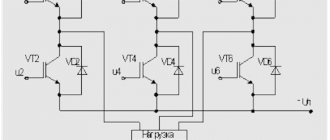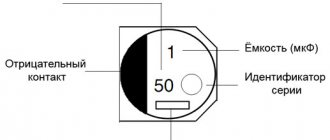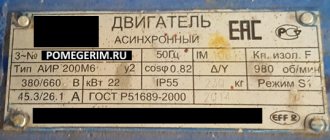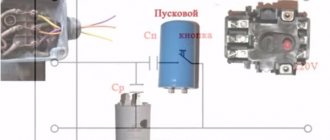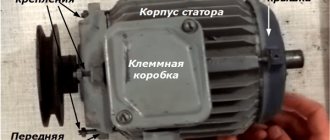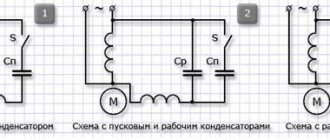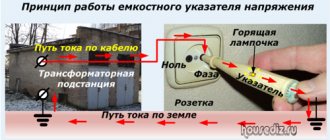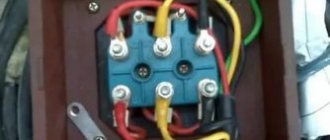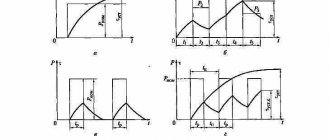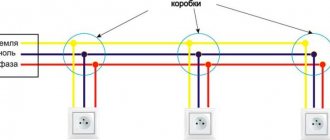A loop is when each subsequent outlet is connected to the previous one in parallel, and a star is when a separate line goes from each outlet to an electrical panel or distribution box.
Then, in the first case, you need to check the condition of the terminal blocks and contacts in the previous working outlet in the circuit, and in the second case, inspect the junction box.
In one room
If there is no phase in one of the rooms, pay attention to the electrical panel. If each room is turned on by a separate machine, the machine for this room may have been knocked out, or it may have malfunctioned. In the first case, look for problems in the wiring of the room, and in the second, replace the machine.
If all the rooms are powered by the same circuit breaker, then the problem is in the distribution box that powers that room.
No light in an apartment building
If you find that not only you, but also all your neighbors in the riser have problems with the electricity supply, it means that there has been a break in one of the three phases either in the incoming electrical panel of the house or in one of the access panels. This happens when zero burns out and phase imbalance occurs, when due to overvoltages the load and its currents are unevenly distributed among consumers. As a result, the contacts of one of the connections do not withstand and burn out.
In this case, you cannot fix the malfunction yourself; you need to contact the management company or supply organization so that they send a team of electricians on duty.
Less often there are cases when two phases disappear. In this case, as in the previous ones, you need to check the condition of the circuit breaker terminals on your apartment switchboard and, if all the contacts and terminals of the circuit breakers are apparently in good working order, call a team of electricians.
Independent troubleshooting of access electrical panels is dangerous because you cannot fully disconnect all lines and hang prohibiting posters.
In a private house
If you find that there is no voltage in the network, look at the input circuit breaker; if it is knocked out, turn it on. If after turning on the machine the voltage does not appear, the problem is in the input into the house. It is also possible to lose contacts on the machine. And if, when you turn on the machine, it immediately knocks out, there is definitely a short circuit either in the wiring or in one of the connected devices.
Consequences
For an electric motor, operating in two phases out of three is emergency and extremely undesirable. Also, in three-phase networks, due to the loss of one of the phases, the uniformity of the load of the transformers and the network as a whole is disrupted. For a three-phase electric stove, this mode of operation is not so dangerous - some burners simply will not work. All this leads to increased current in the neutral wire, its possible burnout and further development of emergency situations.
In conclusion, I would like to note that the solution to the problem of lack of voltage in an apartment or on a specific line essentially lies in checking all connections and switching equipment of this line. There are only two reasons for it - either phase imbalance, or burnout of the conductor due to poor contact or increased load. We strongly recommend: when working in electrical wiring, turn off the power and, if possible, work with approved dielectric gloves. Do not interfere with access switchboards and electrical networks - it is better to have this done by electricians from the organization on whose balance sheet this network lies.
Now you know the reasons why a situation arises when there is no phase on the light switch, socket or on the chandelier itself. We hope the tips we provided helped solve your problem!
A little theory.
Without going into technical details, we can say that a single-phase electrical network is a method of transmitting electric current when alternating current flows to the consumer (load) through one wire, and returns from the consumer through another wire.
Let's take, for example, a closed
an electrical circuit consisting of an alternating voltage source, two wires and an incandescent lamp.
From the voltage source to the lamp, current flows through one wire and, having passed through the filament of the lamp, making it hot, the current returns to the voltage source through another wire. So, the wire through which current flows to the lamp is called phase
or simply
phase
(
L
), and the wire through which current returns from the lamp is called
zero
or simply
zero
(
N
).
When, for example, a phase wire breaks, the circuit opens, the flow of current stops and the lamp goes out. In this case, the section of the phase wire from the voltage source to the break point will be under current or phase voltage
(phase). The rest of the phase and neutral wires will be de-energized.
If the neutral wire breaks, the flow of current will also stop, but now the phase wire, both terminals of the lamp and part of the neutral wire extending from the lamp base to the break point will be under phase voltage.
You can use an indicator screwdriver to make sure there is a phase on both terminals of the lamp and on the neutral wire coming from the lamp. But if you measure the voltage on the same terminals and wire with a voltmeter, it will not show anything, since in this part of the circuit there is the same phase, which cannot be measured relative to itself.
Conclusion: there is no voltage between the same phase. There is voltage only between the neutral and phase wires
.
Advice
. To determine the presence of phase and voltage in the electrical network, it is necessary to use an indicator screwdriver and a voltmeter together. You can use it as a voltmeter.
Now let’s move on to practice and consider some situations with zero that you can independently determine and, if possible, eliminate without involving the utility service:
1. Zero break in the entrance panel of a house or apartment
;
2. Zero break at the input or inside the distribution box
;
3. Short circuit of the neutral conductor to the phase conductor in case of mechanical damage to the insulation
.
1st phase disappears (380V in a private house)
I ask for an authoritative opinion on the problem!
The house is connected to 380, then the load is distributed along the star through an RCD and three groups of circuit breakers.
A couple of days ago, when turning off the lights in one room, the 1st phase disappeared. No machines turned off, and on the Mercury meter the indicator of the first phase began to blink, the rest were normal.
After two hours the phase turned on itself. The next day, when I turned on the button on the extension cord in the same room, the same phase disappeared again. She recovered a few hours later when the rain started.
Then a repair team arrived and the technicians said that the contact had gone sour and that we could contact him again; if the problem returned, we would need to “stretch it out.”
Today, when I turned on the light in the same room, this phase disappeared again. Before this, everything worked fine all day - on/off.
It is very confusing that there is no phase on the meter, that is, the problem seems to be outside my home network, but it is clearly induced inside the house. At this same phase, I also have a deep-well pump, and it clearly consumes more than light, and the automatic switching on/off of the pump did not cause a phase loss.
The remaining phases and the load in the house live on them as before.
What can you advise in such a situation? How can this be and what can be caused?
I tried to turn off all the machines and ouzo during this phase, and completely turn off the input to the house - this does not lead to the restoration of the phase. (I look at its flashing indicator on the meter, and the indicator screwdriver also shows the absence of a phase). Recovery occurs on its own, for no apparent reason. I don’t know if the rain played a role the second time.
The neighbor, who is powered by the same pole, is fine, all phases.
datamove , The contact on the pole disappears. Until they fix it, you need to switch the pump to another phase.
Thank you! And what disappears at the moment of switching on and off inside the house - how can this be explained?
datamove wrote: what disappears when you turn it on and off inside the house
The load changes - the starting current to the burnt contact.
I did the job - the main thing is to avoid gratitude.
datamove wrote: Hello! I ask for an authoritative opinion on the problem! The house is connected to 380, then the load is distributed along the star through an RCD and three groups of circuit breakers. A couple of days ago, when turning off the lights in one room, the 1st phase disappeared. No machines turned off, and on the Mercury meter the indicator of the first phase began to blink, the rest were normal. After two hours the phase turned on itself. The next day, when I turned on the button on the extension cord in the same room, the same phase disappeared again. She recovered a few hours later when the rain started. Then a repair team arrived and the technicians said that the contact had gone sour and that we could contact him again; if the problem returned, we would need to “stretch it out.” Today, when I turned on the light in the same room, this phase disappeared again. Before this, everything worked fine all day - on/off. It is very confusing that there is no phase on the meter, that is, the problem seems to be outside my home network, but it is clearly induced inside the house. At this same phase, I also have a deep-well pump, and it clearly consumes more than light, and the automatic switching on/off of the pump did not cause a phase loss. The remaining phases and the load in the house live on them as before.
I came across similar garbage (if you happen to have it) 2 times in the Moscow region and 2 times in Moscow: when connecting a meter, network installers specially make the connection in such a way that for some time it (the connection) begins to fail (insufficient contact screws or they simply put the core under 1 screw, insufficient stripping of the cores). As a result, you end up with a paid fix for a problem created specifically by the networks themselves.
Zero break in the entrance panel of a house or apartment.
In the input panel of a house or apartment, the neutral wire may break at the input circuit breaker or at the neutral bus. As a rule, the screw connection becomes loose, causing contact between the wire and the clamp to be lost, or, in rare cases, the neutral wire breaks off at the clamp and hangs in the air.
Also, due to poor contact between the clamp and the wire, the wire heats up and burns and, as a result, a large transition resistance in the form of soot forms
, which gradually turns into a cliff.
If there is no zero, all electrical appliances in the house will not work. But if at least one household appliance remains plugged in or the light switch remains on, the phase through the radio components of the power supply
household appliances or
filament
will pass unhindered to the zero bus, and from the bus to all neutral wires of the electrical wiring. And as a result, there will be a phase on both sockets of sockets and contacts of switches. This is because all the neutral wires of the electrical wiring are connected together at the neutral bus.
To determine such a malfunction, it is enough to unplug all household appliances from the sockets and turn off all light switches or unscrew the light bulbs. After these actions, the second phase from the sockets and switch contacts will disappear. The malfunction is treated by restoring the contacts on the terminals of the input circuit breaker or on the zero bus.
Why does the phase disappear?
The vast majority of electrical accidents occur during periods of active use of electrical appliances, especially when connecting new equipment with high power consumption. However, it also happens that residents discover a malfunction in the absence of any prerequisites for this: the lights in the entire house simply do not turn on, and the sockets are de-energized. What is characteristic is that there are no signs of fire anywhere, and the automatic safety equipment, as it should be, remains in the on position. During subsequent analysis of the wiring, it turns out that there is no phase or zero in the supply circuit, but where and how the break occurred remains a mystery. Today we will talk about the possible causes of this malfunction, as well as ways to eliminate it in various cases.
Unlike many other situations, the root cause of the current circumstances is completely clear - a circuit break occurred. However, the manifestation of this can look different: a physical break in the main cable or wire, lack of contact in the terminal, etc. It may seem that if there is a missing phase only on the power supply circuit of the lamps (when the circuits of the sockets are not affected by the malfunction), finding the location of the break will be easier , but in reality this is not true. Sometimes local electrical accidents turn out to be a much bigger puzzle than damage to the main supply lines.
There is no voltage in the socket and the light is on. What to do if the lights go out or there is no electricity
I’ll say right away that the article is not for electricians, but for ordinary citizens, consumers of electricity. This article may seem like a lot of water, but you must understand that I have a great responsibility - after all, in giving these tips, I am like a doctor prescribing medicine remotely.
Diagnosis of the problem
In most cases, the absence of a phase is detected quite quickly. If a consumer tries to turn on a chandelier in a room, he usually thinks that the light bulb has burned out, but this guess can be easily verified by placing the lamp in a different socket or simply flicking switches from other lamps in the house. When connecting equipment, it often happens a little differently: having connected a device to several sockets, consumers usually believe that it is this one that is broken, since we are all accustomed to the stability of the power circuits. The essence of the breakdown is discovered a little later, when it turns out that all electrically dependent devices have “broken” at once. The situation often gets worse when the power to the lighting circuits is not damaged, and consumers wonder what exactly in their home has stopped working.
First, let's consider the case when there is no light in the home, but the sockets are working properly. To diagnose the situation, you can use a regular indicator screwdriver, which can be used to check the voltage in the socket of any stationary lamp. This must be done with caution so as not to accidentally cause a short circuit. If the test results confirm that power is not being supplied to this location, you need to check the connections upstream. First of all, the place where both wires are connected to the cartridge itself is inspected - perhaps the threaded fastening has simply become loose and the solution to the problem will be to tighten the clamping screw. If everything is in order, you need to disconnect the conductors from the cartridge and ring them separately in order to understand whether current is flowing through them. Then attention is turned to the terminal block, which connects the lamp or chandelier to the power line laid in the wall - perhaps this is the problem. Here again, poor clamping of the core or melting of any parts that prevent the passage of current may occur.
After checking the area inside and near the lamp, you should move on to other electrical components. In order to ensure the integrity of the conductors powering the device, you will need a special test. One of its probes should touch the output of the core in the junction box or mounting cup of the switch, and the second should touch the contact in the socket directly. It is often discovered that the fault is caused by a broken wire. Sometimes the damage itself could have happened quite a long time ago, but the final rupture occurred today. If the consumer knows that he recently did some minor work in the house (hanging a mirror, a picture or a bookshelf), first of all, you should use a test screwdriver to test the area near these new fasteners. It is quite possible that the absence of electromagnetic interference on the one hand will tell about the root cause of the malfunction of a particular electrical point.
If the integrity of the conductor is confirmed, it is necessary to examine the fastening of the conductors to the switch terminals. Sometimes the malfunction is not visible to the naked eye: the mechanism does not melt, clicks with a normal sound and does not heat up during operation, which is why it seems that it is working properly. But if you take it apart, it turns out that the problem still lay somewhere inside it. To diagnose a malfunction, you can take the long route: take a continuity test and sequentially check one link of the product after another until the location of the breakdown is localized. However, a faster and more radical method is often used: it is necessary to take a known-good terminal block or self-clamping terminal block and connect the wires directly, and then apply previously disconnected power to the panel. If the light comes on, the fault was definitely in the switch, and therefore, instead of lengthy manipulations with it and searching for a specific location of the breakdown, it will be enough to simply purchase a new element of electrical accessories and install it in its place.
A more rare malfunction is when all the elements of the circuit seem to be working properly to the technician, and the phase disappears precisely at the moment the lamp is turned on. The reason for this may be either a current leak in the circuit somewhere on the wiring section in the wall, or a short circuit, however, in the latter case, the circuit breaker in the input panel must still respond to the fault. In the case when the power does not even reach the switch, it is necessary to continue examining the circuit further: to study the reliability of switching the cores inside the distribution box, as well as between it and another box on the supply line or between it and the apartment panel itself.
If a lack of power is detected in the outlet, then there may be a greater variety of malfunction options. To begin with, of course, it is necessary to carefully study the mechanism itself - both visually and using dialing. Particular attention must be paid to the connecting terminal blocks - screw connections and clamps are always the most vulnerable point of electrical accessories. If it becomes clear that the problem is not in the socket mechanism, you should remember according to which scheme all the equipment is connected - a cable or a star. Even if you do not have information about this, an indirect conclusion can be drawn from whether other outlets in the room work. Often, when connected by a loop, several of them will not work at once, and when switched by a star, the fault can be localized within one electrical unit.
Let us explain: a loop is understood as a method of connecting electrical points in which each subsequent one is separated from the previous one in series, and when connected by a star, each node is directly connected by a separate line to the distribution box or input panel. It is easy to understand that in the first case, damage to any intermediate link with a high degree of probability can affect subsequent ones, and with independent switching, only a breakdown in their common center can disable all electrical points at once.
When dealing with grounded sockets, do not forget that a broken phase conductor could cause current to flow into the third wire. Thus, there is a possibility that the phase is still present in the circuit, it simply goes along the wrong wire, and therefore, when testing the conductors in the socket, you should not limit yourself to checking only the main pair of conductors. The fact that the circuit breakers did not work does not mean a complete absence of a phase in the supply circuit. In addition, it is always necessary to take into account possible incorrect electrical installation. There is a possibility that the switching of the cores was carried out not by a qualified electrician, but by a person who has little knowledge of the marking of conductors, which is why the entire circuit is incorrectly connected to the sockets and the input panel.
How to properly connect zero to ground
Incorrect connection of zero to ground can cause tragedy, instead of protection. In a common house input device (IDU), the combined zero must be divided into working and protective conductors. Then the protective zero should be routed to the shields on the floors, and then to the apartments.
This results in a five-wire network:
- 3 phases;
- N;
- P.E.
PE must be connected to the third contact of the sockets. In old houses there is a four-wire network:
- 3 phases;
- combined zero
If the PE conductor is made in the form of an aluminum busbar, then its cross-section must be at least 16 mm², if the copper busbar (brass) is at least 10 mm2. This rule is valid for ASU; otherwise, you should be guided by the table below.
| Section of phase conductors, mm2 | Minimum cross-section of protective conductors, mm2 |
| S≤ 16 | S |
| 16 | 16 |
| S>35 | S/2 |
Circuit breakers and other disconnecting devices cannot be installed on the PE protective conductor; it must be non-switchable. It is necessary to separate the combined PEN zero before the machines and RCDs, after them they should not be connected anywhere!
Forbidden:
- Connect the protective and neutral contacts in the socket with a jumper, because if the zero is broken, dangerous phase voltage will appear on the housings of household appliances;
- connect the neutral and protective conductors with one screw (bolt) on the busbar in the shield;
- PE and N must be connected to different buses, and each wire from each apartment must be screwed with its own screw (bolt). It is necessary to take measures against loosening of bolts and protecting them from corrosion and mechanical damage (clause 1.7.139 of PUE 7).
This connection is used in modern power supply of residential premises or private houses. Which meets the requirements of PEU-7 (clause 7.1.13) for direct and alternating current networks with a voltage of 220/380 volts. After separation, combining them is strictly prohibited.
In a private house, we often receive two or four wires from overhead power lines. Most often there are 2 situations:
Situation #1 is a good case. Your electrical panel stands on a support, and a re-grounding is driven under it. There are two buses PE and N in the electrical panel. The zero from the support and the wire from the grounding conductor go to the PE bus. There is a jumper between the PE and N buses, from the N bus there is a working zero to the house, from the PE bus there is a protective zero to the house. Buses PE and N can be installed in the house in the distribution board, then the neutral is connected to the ground on one bus in the metering board as in the photo below.
The point is to connect the zero and grounding at the input to all RCDs and automatic circuit breakers, and from this point lead the phase, neutral and ground to the consumers.
Such boards are now often assembled when connecting new private houses to the power grid. In this case, the input circuit breaker is installed in phase, the zero from the overhead power line goes directly to the meter, and the division of the zero (connection to the grounding conductor) is made after it. Less often this is done before the meter, but energy sales are often against such a decision. Why? Nobody knows, they argue about the possibility of electricity theft (the question is how?).
Situation No. 2 - The metering board can be either on a support or in the house or on its facade, it doesn’t matter. You have a sealed input machine and a meter, respectively, you have one or three phases and zero. How to make grounding and is it necessary to connect it to zero? If the overhead power line is new, it is necessary. As in the previous case, you will receive a TN-CS system. Then: the zero from the meter is connected to the PE bus, to which is a wire from the ground electrode (which you will make yourself on your site).
If the overhead power line is old, there is no need to connect the neutral and the ground (Chapter 1.7. PUE clause 1.7.59). Make a TT system (without connecting PE to N). In this case, be sure to use an RCD!
In both situations, each wire on the busbars must be tightened with its own bolt - do not put multiple PE or N conductors under one bolt (or screw).
If you live in an apartment, we recommend reading this article: https://samelectrik.ru/kak-sdelat-bezopasnoe-zazemlenie-v-kvartire.html.
Reasons for lack of phase
It’s worth saying right away that the phase disappears for one reason - there is no contact. It does not matter whether the cable is broken or the disconnector at the transformer substation is open. Moreover, everything is said for both three-phase and single-phase networks.
Also, not everyone knows that a single-phase 220V network is one of the phases of a three-phase network with a linear voltage of 380V, and between phase and zero in this case it turns out to be 220V. Let's look at what to do if a phase is lost using the example of different situations.
Lighting doesn't work
If there is no light, but the sockets are working, first check for voltage in the socket on the chandelier. In this case, you can check the presence of a phase with an indicator screwdriver, but be careful - there is a high probability of causing a short circuit.
If there is nothing there, there may be a problem in connecting the wires to the cartridge; if this is all right, then, most likely, a phase has disappeared in the switch or junction box.
This often happens when the switch contacts seem to close, but there is no connection between them, and also if the wires were poorly clamped in the switch terminal block. To check the switch, you need to remove it from the wall and ring whether the contacts close when the switch is closed, and at the same time check whether voltage is coming to it.
If there is no voltage at the switch, the problem is in the junction box or in the wiring between it and the switch. If a phase disappears when you turn on the light, you have a short circuit in the socket, lamp, or in the line from the switch to the lamp.
The socket does not work
There may also be a phase loss in the sockets. This can be easily checked by removing the non-working socket and inspecting the quality of the connections to the wires. If the connections are good, then you need to know how the sockets are powered. In total, there are two connection schemes:
- A train.
A star.
A loop is when each subsequent outlet is connected to the previous one in parallel, and a star is when a separate line goes from each outlet to an electrical panel or distribution box.
Then, in the first case, you need to check the condition of the terminal blocks and contacts in the previous working outlet in the circuit, and in the second case, inspect the junction box.
In one room
If there is no phase in one of the rooms, pay attention to the electrical panel. If each room is turned on by a separate machine, the machine for this room may have been knocked out, or it may have malfunctioned. In the first case, look for problems in the wiring of the room, and in the second, replace the machine.
If all the rooms are powered by the same circuit breaker, then the problem is in the distribution box that powers that room.
No light in an apartment building
If you find that not only you, but also all your neighbors in the riser have problems with the electricity supply, it means that there has been a break in one of the three phases either in the incoming electrical panel of the house or in one of the access panels. This happens when zero burns out and phase imbalance occurs, when due to overvoltages the load and its currents are unevenly distributed among consumers. As a result, the contacts of one of the connections do not withstand and burn out.
In this case, you cannot fix the malfunction yourself; you need to contact the management company or supply organization so that they send a team of electricians on duty.
Less often there are cases when two phases disappear. In this case, as in the previous ones, you need to check the condition of the circuit breaker terminals on your apartment switchboard and, if all the contacts and terminals of the circuit breakers are apparently in good working order, call a team of electricians.
Independent troubleshooting of access electrical panels is dangerous because you cannot fully disconnect all lines and hang prohibiting posters.
In a private house
If you find that there is no voltage in the network, look at the input circuit breaker; if it is knocked out, turn it on. If after turning on the machine the voltage does not appear, the problem is in the input into the house. It is also possible to lose contacts on the machine. And if, when you turn on the machine, it immediately knocks out, there is definitely a short circuit either in the wiring or in one of the connected devices.
Household methods for checking the presence of grounding
If it is clear why grounding is needed in an outlet, then the question remains of how to find out whether it works - after all, in practice, the zero in the network is always grounded and, in fact, the connection goes through the same wire. Here you need to understand that in some cases grounding is an additional zero, but if possible with less wire resistance. It is also necessary to take into account that the wiring in the apartment can be done correctly, but if there are no separate terminals for grounding on the access panel, then the wire may be left unconnected until a separate grounding bus is installed in the house.
For the simplest test, you need a voltage indicator or tester, a test light and a screwdriver.
Visual inspection
The first thing you need to look at is the design of the sockets in the house - they may only have two holes for a plug or with additional contacts.
In the first case, it is clear that the design of the sockets themselves does not provide for grounding. The second is that connecting protection to them is possible in principle, but whether it actually exists needs to be checked additionally.
Next, the outlet itself is disassembled - here you need to look at how many wires come out of the wall and what color they are. According to standards, the phase is connected with a brown (black, gray, white) wire, zero with blue, and grounding with two-color yellow-green. In older homes, this may simply be two or three wires of one color. If only two wires are used, then this clearly indicates a lack of grounding. If three wires come out, then additional testing will be required.
Additionally, you need to inspect the panel near the electric meter - if only two wires enter the apartment, this also indicates that there is no grounding initially.
Grounding in the absence of grounding
There is a possibility of detecting only two wires entering the apartment, but when inspecting the sockets, it is clear that the grounding contacts and the neutral wire are short-circuited with each other by a jumper. This connection option is called grounding, but its use is prohibited by the rules of the PUE, since in the event of a short circuit, the voltage immediately appears on the housings of the devices and there is a high probability of electric shock to a person.
Even without a short circuit, such a connection is dangerous in case of a fairly common breakdown - the neutral wire burns out on the input circuit breaker. In this case, the phase through the contacts of the devices ends up on the neutral wire, which, after a burnout, is not connected to ground. The voltage indicator will show the phase in all socket contacts.
About what grounding is and why it is dangerous, watch this video:
How to determine the presence of grounding
If three wires are brought out to the socket and they are all connected to it, you can check the functionality of the grounding with a tester or a regular light bulb.
To do this, you need to determine which wire the phase is on, which is done with a voltage indicator. Moreover, if a phase is detected on two wires, then the network is faulty.
When a phase is found, the light bulb is touched with one wire, and the second is alternately touched to zero and ground. When you touch the neutral wire, the light bulb should light up, but whether there is grounding, you need to look at its behavior - the following options are possible:
- The light does not light up. This means that there is no grounding - most likely, the wire is not connected anywhere in the distribution panel.
- The light bulb glows exactly the same as when connected to the neutral wire. This means there is grounding and in the event of a short circuit the current will have somewhere to go, but there is no protection that responds to leakage current.
- The light bulb begins to glow (in some cases it does not have time to light up), but immediately the electricity in the entire apartment turns off. This means that the grounding is connected and working correctly - there is an RCD on the input panel of the apartment that cuts off the voltage when a leakage current occurs, which goes to the grounding wire.
When checking, you need to pay attention to the brightness of the light bulb or what values the voltmeter shows. If, compared to the connection to the neutral wire, the light bulb glows dimmer (or the voltage is less), then the resistance of the ground wire is higher and its efficiency is low
Triangle.
To transmit electricity between populated areas, the voltage of the electrical network is increased many times. This is done to reduce the current load of the network; in other words, as the voltage increases, the current strength in the power lines decreases.
For example, if, when arriving at the ASU of residential buildings, the linear voltage of the network (between phases) is 380 Volts, then on high-voltage power lines the voltage can increase from 6,000 to 1,150,000 Volts.
The reduction to 380 Volts occurs inside transformer substations where a step-down current transformer is installed.
In electrical engineering, there are two schemes for connecting the windings of step-down transformers: “star” and “delta”. In most cases, in modern electrical networks for domestic needs, a “star” circuit is used, everything is standard here, there are 3 phases and zero (solidly grounded neutral). Line voltage = 380 Volts (voltage between phases), and phase voltage = 220-240 Volts (between phase and zero, ground).
As a rule, the ASU receives a four-core cable through which a voltage of 380 Volts is supplied, then it is divided into separate “zero + phase” lines, which come to the apartment. As a result, at the outlet we get a network voltage of 220-240 Volts.
But in the “triangle” there is no zero, there are only three phases and that’s it. The ASU comes with a three-core cable, through which a voltage of 380 Volts is supplied.
Since in a triangle circuit the phase voltage = linear, it is then divided into separate lines “phase + phase” and it is in this form that the voltage comes to residential apartments. That is, in such a network there will be two phases on both contacts of the socket, while household electrical appliances will function properly in normal operation. The outlet will have a voltage of 380 Volts.
It is worth noting that the triangle pattern in modern networks is becoming less and less common, in most cases in areas of cities and villages with old housing stock.
It’s quite unpleasant to encounter a problem when the socket suddenly fails. There are two main types of faults, but there are many more variations, as well as ways to eliminate them.
These include:
- The tension has completely disappeared;
The socket has two phases.
Let's figure out why all the sockets or one of them stopped working. But first, familiarize yourself with the design of the outlet.
What does a socket consist of?
First you need to know the device of the outlet itself. First of all, you see the front panel mounted in a frame. They are screwed to the main part with 1, less often 2 screws. After removing the front part, we see the main part, which is fixed in the socket box using two expanding claws, and they are fixed with 1 screw each. When you tighten the screws, the arms straighten and lock, and when you loosen them, the arms lower and you can remove the socket from the wall.
If the socket is single, you see two holes for the plug located horizontally in the center, they lead to the conductive busbars. There may be no holes, then a tire will immediately appear in front of you, as in the photo below.
The wire to the socket is connected through a clamping screw into the terminal block. Be careful there is tension on the screws, do not grab the tip of the screwdriver when unscrewing them.
One outlet in the room does not work, but the rest are fine
You plugged in an electrical appliance, but it showed no signs of life. You need to check for the presence of a phase; if there is only one phase and it is present, then there is a problem with the neutral wire; if there is no phase, check for the presence of zero - this can be done by ringing the socket connector with a neutral to a similar one in another socket, having first made sure where the phase is on it and where the zero is (most often there is an indicator screwdriver) or to the grounding terminal, depending on the type of wiring and grounding in a particular room or installation.
If it turns out that only a phase is missing or it is not in the same place as zero, it means that somewhere the contact has disappeared due to oxides, carbon deposits, or the wire has burnt out. First of all, you need to disassemble the socket; to do this, you need to unscrew 1 or 2 fastening screws to remove the front panel.
All operations must be carried out with a tool with dielectric handles, with the input circuit breaker or the socket group circuit breaker turned off.
Next you will see the socket itself, its conductive bars and frame. To remove it from the socket box, you need to loosen the fastening screws, after which the mounting brackets will loosen. Next, inspect the connection of the wires to the outlet. If they are burnt out, clean them and reconnect them. Inspect the terminal blocks to which they are connected. If they are in place and not burned, then they need to be cleaned to a shine with sandpaper or a small file.
If the housing near the terminal blocks has melted, it is better to replace the socket. Sometimes current can flow through the carbon deposits and this will cause further problems.
To reconnect the wire, you need to unscrew the screw from the terminal block, insert the wire and tighten it. Be careful, the wire must be stripped just enough so that the exposed part is completely hidden in the terminal in order to avoid short circuits. Sometimes it may not work due to the fact that the place where the plug is inserted is covered with a layer of soot or oxide, try cleaning it.
All electrical connections and contact points must be well cleaned and shiny, then the contact will heat up less and last longer.
There is no voltage in the socket but the wires are connected to it
Voltage may reach the outlet, but disappear there if the tires are cracked or burned out. To check whether there is voltage on the cable, you do not need to disconnect it - just use the probes of a measuring device or indicator to touch the caps of the mounting screws.
If the device shows “zero”, remove the socket and wires from it. Re-measure when you are sure that the cables are de-energized and begin searching for the location of the break or loss of contact.
Types of socket connections: loop or star
To deal with this problem, you need to know how the connections are made in your case. There are two types of connection:
2. Star.
A cable is more common: the cable is connected to the first outlet and from it to the subsequent ones. The advantages are obvious: low copper consumption and less . But the disadvantages are: if the cable from one of the sockets burns out, all those connected after it also stop working.
In addition, when a high-power load is connected to the last socket, the load falls on 1 cable, and the remaining sockets can no longer be loaded. This is equivalent to the situation when you have 1 socket and a bunch of tees and extension cords are inserted into it.
Connecting sockets according to the star scheme is as follows: each of the sockets in the apartment is connected with a separate cable to the input circuit breaker or distribution box of the room.
Troubleshooting
Regardless of the method of connecting the outlets, the first thing you need to do is find the nearest junction box and open it. Next you need to inspect the connections for burnouts and melting of the insulation.
If the sockets are connected with a cable, the situation is simplified. Distribution boxes are often covered with wallpaper or, worse, plastered or covered with plasterboard. Then you need to open the sockets in the entire room and check whether the cables have burned out from them.
If during inspection you do not find any faults, then the cable is damaged in the wall. Then the repair becomes much more complicated and you need to drill into the walls to find where the wires are damaged.
If the sockets are connected with a star, inspect the apartment electrical panel; the wire may have come loose from the terminal. The machine needs to be replaced and the connections restored.
All outlets stopped working
Repair in a situation where not a single outlet in the room or in the entire apartment works is similar. If the sockets are connected using a cable, then start checking the connections in the socket boxes. In this case, special attention should be paid to the first outlet in the circuit - all the others are powered from it. If there are no problems in the cable, inspect the junction box.
When connecting with a star, most likely the circuit breaker of the socket group was knocked out or failed. If the entire apartment is powered by one circuit breaker, then look at the first distribution box after the panel - it should have a socket connection.
Where do the sockets have two phases and how to restore their operation?
The answer is simple and short - a break in the neutral wire. The fact is that in an open circuit, even if the neutral wire breaks, the end on the side of the supply phase will be at potential. That is, both wires will be live.
Current flows only in a closed circuit. But the voltage at zero appears through the load; if you turn off all consumers (lamps, heaters, household appliances), the second phase in the outlet will disappear, and this will not help the matter.
You need to look for such a fault as close as possible to the beginning of the wiring - the meter or electrical panel. If there are no problems in the apartment, look outside it. Check the connection at the access distribution board. When you restore zero everything will return to its place.
Conclusion
The main problem of voltage loss is a cable break or burnout; restoring this problem may take minutes, or maybe several days, and the cost of such restoration will be repairs in the apartment, since you will have to chisel the walls.
The main thing is to follow safety precautions and turn off the input machine to the apartment or room. Do not work with wet hands or on wet floors and walls; if possible, use insulated tools. Despite the simplicity of the operations, do not try to perform them if you have no experience with electricity - it is very dangerous.
Zero break at the input or inside the distribution box.
If the neutral wire breaks in front of the distribution box or in the box itself, the problem with the neutral and the operation of electrical equipment will be precisely in the room of the house or apartment into which this box distributes voltage. At the same time, everything in the neighboring rooms will work as normal.
In the figure above you can see that in front of the left distribution box the neutral wire has broken, and the phase through the lamp filament (load) reaches the socket neutral.
When searching for such a fault, the problem box is opened and the common zero twist is found (it is the thickest in the box). The strands are cut off, re-cut and twisted together again.
Advice
. If the wire is copper, then it is advisable to solder the twist.
When the zero breaks in front of the distribution box, as shown in the top figure, to find the break, you often have to open the groove with this wire in the wall to find the location of the damage.
When searching for such a fault, first they find a twist in the box with a common zero and unwind it into separate wires. Then each neutral conductor is called up to the sockets and to the ceiling. The core that will not ring will be the incoming wire into the box.
Next, this wire is pulled through and the plaster in the wall is opened to look for where the wire is damaged. However, such a malfunction is classified as difficult to solve, because few people undertake to pick at the wall - it’s easier to lay a new route.
Induced current
The socket operates in normal mode, but when measuring, the indicator diagnoses two phases. This phenomenon often occurs if there is a high-voltage power line near your home.
This is one of the most dangerous cases, since the induced voltage will be diagnosed by the indicator even when the voltage supply to the apartment is completely turned off, which can mislead even a professional in this matter. In this case, a voltmeter or multimeter will help; it will accurately show the presence or absence of voltage.
Overvoltage has occurred
- Overvoltage is an increase or decrease in voltage values from normal (220-230 volts) to high (360-380 volts) or vice versa low (40-80 volts). When an overvoltage occurs, the light may blink at first, then the light bulbs begin to burn very brightly or very dimly.
The main danger is when the voltage increases (360-380 volts). Light bulbs begin to glow strongly, in some cases even hum, and household electronics begin to smoke. React instantly to increased voltage: computers, microwave ovens, electronic watches, televisions, audio and video equipment. They burn out or start to work incorrectly.
At low voltage values (40-80 volts), such significant damage to household appliances is not caused; due to the low voltage, it simply does not turn on, and the lighting barely glows, so that you can see the barely smoldering filament in the light bulb. The reason is very commonplace: somewhere along the electrical wiring line from the substation to your meter, the neutral wire was damaged.
What happens during overexertion? Modern electrical networks use four-wire cable lines. Three wires are used to transmit three independent phases, and the fourth for zero. When the neutral wire is damaged, the current, like water, instantly fills the free niche and rushes to where the smallest load is, as a result, it turns out that two phases arrive along the phase wire and along the neutral wire instead of the required 220 volts, so it turns out 380. Accordingly, since the current has escaped into the free niche with a small load, then where it escaped from there remains a small voltage (40-80 volts) or nothing at all.
What to do?
- Need to quickly turn off the power supply to the apartment
- unplug all household appliances
- turn all switches to the off position.
- Call electrical service personnel. Wait until the team of electricians eliminates the causes of the overvoltage, then they take control measurements of the voltage, draw up a report, and only after that can the power supply to your apartment be restored again.
Short circuit of the neutral conductor to the phase conductor due to mechanical damage to the insulation.
A situation may arise when, when drilling a hole, screwing in a self-tapping screw, or hammering a nail into a wall, the electrical wiring is disrupted. In addition to this, damage to the wiring is accompanied by a short circuit, due to which the wire is damaged completely or partially. Such a malfunction is treated by opening the damage site and restoring the damaged section of the wire.
Sometimes with such a malfunction you can also observe two phases in the outlet. At the moment of closure, the phase and neutral conductors are welded together, and therefore the phase freely flows onto the neutral conductor. Moreover, even when the electrical equipment is turned off from the sockets and the lighting switches are turned off, the phase will be present on those sockets and switches that are supplied with voltage from this wire.
The malfunction is treated by restoring the damaged section of the wiring.
If you still have questions, then in addition to the article, watch the video, which also covers the topic of zero loss.
In this article, we examined only the most common faults that occur in a single-phase electrical network when the neutral wire is damaged. Now if you have two phases in your socket
, You can easily identify and fix such a malfunction. Good luck!
Imagine that you came home and turned on the light - the lamp did not light up, then you discovered that there was no voltage in the socket, while the circuit breakers or plugs were intact and turned on. Further inspection may show that a phase or zero in the circuit is missing. In this article we will look at why this can happen and what to do if there is no phase on the switch, socket or chandelier.
The neutral wire in the internal wiring system has burned out
This is the most common reason. In the absence of a neutral connection, the phase through the filament of light bulbs in a chandelier, or through electrical appliances connected to other sockets by induced current will also be present on the neutral wire. In this case, the socket, which contains two phases, does not work. This cause can be correctly diagnosed by turning off the electrical appliances plugged into them from all sockets by disconnecting the plugs from the sockets. Next, you need to turn all switches to the off position. If you don’t know in which position the switch is on and in which it is off, you can simply unscrew the light bulbs from the chandeliers and lamps, the effect will be the same. After you have completed all the steps indicated above, you need to check the voltage in the outlet again. You should get the following: there should be a phase on the phase wire, accordingly the indicator gives a light warning, and when you touch zero, the indicator light should not light up. In this case, you should start looking for the cause of the problem:
- in places where paintings and photographs were recently hung on the wall. As a rule, in 95% of cases, such home tuning ends with a broken wire. In this case, you need to turn off the power supply to the apartment (turn off plugs, circuit breakers, package switches) and make sure there is no voltage. Next, remove the layer of plaster and release the wire, visually diagnose the location of the damage and eliminate the fault by connecting the wires and insulating them. After all the work has been completed, turn on the power supply and check the functionality of the outlet. After this, the damaged area can be covered with plaster or gypsum mortar.
- if no work was carried out to update the design of the housing before two phases appeared in the socket
, then a possible malfunction may be in the distribution box. In this case, you should start your search with distribution boxes, which are located in the room where the outlet is located. We turn off the power supply to the apartment, remove the cover of the distribution box, look for burnt, melted or fallen off wires. If there is no fault in this junction box, open the nearest one. Once you have visually diagnosed the problem, we proceed to fix it. We make a new connection, isolate it, close the lid of the distribution box, turn on the power supply and check the functionality of the outlet. - in the electrical panel. If you have access to the power panel, you can open it and visually view all the contacts and connections. If you find melted wires, burnt contacts, or wires that have fallen off the connection points, you must immediately contact the organization servicing this electrical panel to troubleshoot the problem. Carrying out independent repairs without relieving tension is DANGEROUS TO LIFE.
